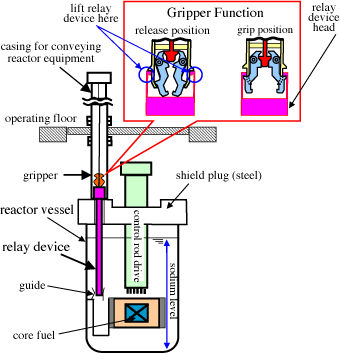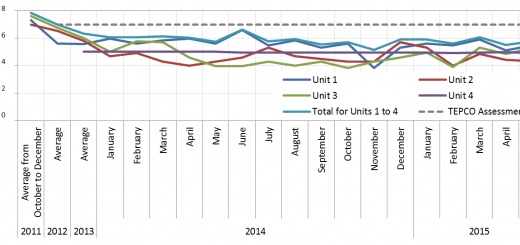Accident at Monju 3 ton fuel loading device dropped into reactor Nuke Info Tokyo No. 138
An accident occurred on August 26 at the Monju Prototype Fast Breeder Reactor (280 MWe) in Tsuruga City, Fukui Prefecture. Full details have not yet emerged, but it seems that it was quite serious. As usual, notification to the local authorities was late. On August 27 the Nuclear and Industrial Safety Agency (NISA) demanded a report on the cause of and response to the accident, including “the circumstances of the event, the impact on equipment, and the reasons for the time required for notification”.
 According to the announcement by Japan Atomic Energy Agency (JAEA), which owns and operates Monju, at 14:48, while removing a relay device used when replacing fuel, the device dropped back into the reactor vessel. No radioactivity was detected, so it is assumed that the fuel was not damaged.
According to the announcement by Japan Atomic Energy Agency (JAEA), which owns and operates Monju, at 14:48, while removing a relay device used when replacing fuel, the device dropped back into the reactor vessel. No radioactivity was detected, so it is assumed that the fuel was not damaged.
When fuel is replaced in light water reactors the reactor head is removed, but in the case of Monju that is not possible, because the molten sodium coolant must not come into contact with air. New fuel is first inserted through the reactor head through a relay device into a relay rack beside the fuel assemblies in the reactor core (see diagram). Next, a fuel replacement device moves the new fuel from the relay rack to its allotted place. The process is reversed to remove the spent fuel.
Since Monju resumed test operations on May 6, it has undergone the first stage of testing. These core confirmation tests were completed on July 22. Preparations are now being made for the next stage, which involves increasing power output to 40%. As one of the preparatory tasks, replacement of 33 fuel assemblies was begun on August 11 and completed on August 17.
During operation, the abovementioned relay device is usually taken out of the reactor as a precaution in case of earthquakes. The accident occurred when the relay device was being removed after the fuel had been replaced.
According to JAEA’s announcement, when the device had been lifted about 2 meters, there was a sudden loss of load and a sound. The relay device is cylindrical in shape, 55 cm in diameter, 12 meters long and weighs 3.3 tons. Investigations using a fiberscope inserted through the reactor head showed that the grippers that hold the relay device came loose due to rotation of their axis. JAEA says this is the reason why the device fell, but no reason has been given why the grippers’ axis rotated.
One would imagine that there could be serious problems with the lower part of the relay device as a result of the fall. There is a revolving rack attached to the bottom of the relay device and there is equipment to guide fuel into the relay rack. If these were damaged, one would expect that repairs would take a long time. It is not possible to remove the sodium to check the situation and, since sodium is opaque, there are limits to what can be discovered with video cameras. It is likely to be some time before details emerge, or even before an investigation method is established.
Increasing power output to 40% was supposed to begin around June 2011, but presumably this will be delayed. Besides the abovementioned replacement of fuel, preparations include inspection of disassembled water and steam system equipment and replacement of exhaust ducts in which corrosion and holes were discovered. Only makeshift measures were taken to address the exhaust duct problems before Monju was restarted.
Hideyuki Ban (CNIC Co-Director)


